- 18 Jul 2024
- 21 Minutes To Read
- Print
- DarkLight
- PDF
Setting Up New Loan Products
- Updated On 18 Jul 2024
- 21 Minutes To Read
- Print
- DarkLight
- PDF
A loan product allows you to set up in advance the parameters for a type of loan that you wish to regularly offer. Loan products are flexible and highly-customizable templates for creating individual loans.
Creating loan products allows you to categorize, advertize, sort, and compare loan types using easy-to-recognize names that your customers can quickly understand. For example, you may wish to offer a Payday Loan that features a particular interest rate and uses a particular pattern to generate IDs. To do so, you may create a corresponding loan product and set your desired terms. This makes it quick and easy to create the actual individual loans.
´
You can also compare the different products' performance and identify the most successful products as well as those that need to be modified to achieve your goals.
For more information, see Managing Loan Products and Linking Products to Accounting.
Loan products vs. Loan accounts
All loan accounts are associated with loan products. For that reason, the terms and constraints you define when creating a loan product will apply to all of the loan accounts created using that product. However, some attributes can be changed when creating a new account from a product. These may include loan amount constraints or interest rate constraints, depending on the type of loan product being used to create a loan account.

Create a new loan product
To create a new loan product:
- On the main menu, go to Administration > Products > Loans.
- In the bottom-right corner, select New Loan Product.
- Enter all the required information. (We will cover all the configuration options in depth below.)
- Select Save Product.

After saving the product, you can click on Show deactivated products to view all activated and deactivated products. You can later activate a product from the Actions dropdown list.

Filling out the form
Product name
Enter a relevant product name. The new product name should be easily recognizable or associated to the loan's purpose so that staff members or other users dealing with products can easily identify it.
Product ID
The product ID is a mandatory and unique alphanumeric code you give your products, allowing them to be identified in the database.
Product category vs product type
The product category helps us better understand how your product is used so we can provide better service and address the specific needs of your use cases, whereas theproduct type determines the set of features available in the configuration.
To understand which category goes with which type, please see the following table:
| Product Categories | Product Types | ||||
| Fixed Term Loan | Dynamic Term Loan | Interest-Free Loan | Tranched Loan | Revolving Credit | |
| Personal Lending | Yes | Yes | Yes | Yes | Yes |
| Purchase Financing | Yes | Yes | Yes | No | Yes |
| Retail Mortgages | No | Yes | No | Yes | No |
| SME Lending | Yes | Yes | Yes | Yes | Yes |
| Commercial | No | Yes | No | No | No |
If you select the Uncategorized product category, you can select any product type.
Loan product categories
The product category helps us better understand how your product is used so we can provide better service and address the specific needs of your use cases. You must assign categories to all of your products. If your product falls under no specific category, select Uncategorized.

To set the product category for a loan product, choose from:
- Personal Lending: Personal loans for individuals, including vehicle loans, payday loans, and so on.
- Purchase Financing: Financing for retail and e-commerce purchases.
- Retail Mortgages: Non-commercial real estate loans for individuals.
- SME Lending: Loans to small and medium enterprise (SME) customers for working capital.
- Commercial: Complex loans for larger corporations.
- Uncategorized: Accounts that fall under no specific category, such as nostro and technical accounts. If you select Uncategorized, we recommend you to fill in the product description and add the use case of the product.
Product category is included as a column in all product views, and can be used as a column and sorting filter in Custom Views.

Loan product types
Mambu supports five types of loan products:
- Fixed Term Loan: Applies fixed interest for the lifetime of an account. The interest due is calculated when the account is opened, and does not change if a customer over- or underpays.
- Dynamic Term Loan: Interest is dynamically recalculated.
- Interest-Free Loan: No interest is charged. For example, this product type is often used by banks offering Sharia-compliant products.
- Tranched Loan: Allows disbursing a loan over multiple tranches instead of entirely up-front. For instance, if a USD5000 loan is approved, you may disburse USD2000 now and USD3000 later in a two-tranched loan.
- Revolving Credit: Allows multiple disbursements and repayments on the account. It has a payment plan associated with it, in which some amount of principal and interest may be paid.
See also Loans for Groups.
Product state
Select the Active checkbox under State if you would like to make the product available as soon as it is created.
Product description
The product description provides more detailed information about the product and is visible under the product's overview. Other Mambu users can see this information for reference when creating new accounts using this product, so you can include any relevant information or refer to any other relevant documents the customers may need.

Product availability
Product availability controls:
- whether the product is available to Clients, Groups, or Groups (solidarity), and
- which branches in your organization can offer it.
To specify individual branches, uncheck the box next to All Branches and the Branch field will display. Click in the Branch field to select from a list of branches. To filter results, you may begin typing the name of a branch. To remove a branch from the list, click on the red delete icon to the right of the branch name.

When an account is created for a client, group, or branch, Mambu will only allow you to select compatible products from the dropdown list.
New account settings
ID settings allows you to customize the IDs generated for all loan accounts created under this product. You may choose either a random pattern or incremental numbers for your account IDs.
Random pattern
Input masks or templates are used to configure Mambu to generate alphanumeric IDs or values of a fixed, specified length, which match the specified pattern of letters and numbers.
Templates consist of the characters `#`, `@`, and `$`, where `#` specifies a number, `@` a letter, and `$` a number or a letter, chosen at random. For example, `@#@#$` will configure Mambu to generate five-character values of one letter, one number, one letter, one number, and one character that is either a letter or a number, such as `B8J4P` or `P1F62`.
Only letters and numbers may be used - special characters and punctuation are not supported.
Note that the generated values cannot overflow. When all possible values of the specified length run out, no additional values can be generated. For example, the pattern `##` can only produce 100 unique combinations, 0-99. It is important that you specify templates that will provide as many values as you may need into the future.

Incremental number
Some organizations may prefer to use incrementing, sequential ID numbers that begin with a specified number.
To configure incremental IDs, select the Incremental Number option from the dropdown and enter the number you want the sequence to start from. Letters may not be used.

Initial account state
Additionally, you can choose between two default initial states when a new Loan account is created under a given product: Pending Approval or Partial Application.
For more information on the initial account states, please see the article Loan Accounts' Life Cycle and States.
Loan amount
The amount limits set here define the constraints applicable when a user creates a new loan account using this product. Only loan amounts that fall within the minimum/maximum range defined at the product level will be accepted for client loan accounts. The Default Amount is the loan amount populated by default whenever a user creates a new loan account.
These fields may be left empty to configure a product default with no set limits.

Accounts managed under credit arrangements
You may configure accounts created for this product to be managed as part of a line of credit or not.
In the Accounts Managed under Credit Arrangement field, you will find the following options:
- Optional: (default) Accounts may be managed as part of a credit arrangement or line of credit, but it’s not required to have a line of credit extended in order to open an account.
- Required: Accounts cannot be approved if they are not associated with an existing credit arrangement.
- No: Accounts may not be managed under credit arrangements.
For more information, see Creating a New Credit Arrangement.
Tranches
For Tranched Loan products, you can specify the maximum number of tranches in which the loan amount can be disbursed. The number of tranches for a given loan account must be specified when you create it.

Interest rate
Depending on the Loan Product type you have selected, you can choose from up to three available methods for calculating interest as indicated in the table below. For Interest Free loans, there are no options available.
| Type | (Equal Installments) | ||
|---|---|---|---|
| Fixed Term | |||
| Dynamic Term | |||
| Tranched | |||
| Revolving Credit |
For more information on each method, see Interest Calculation Methods in Loans.
Accrued interest posting frequency
Use this option to specify when accrued interest is applied in the account:
- On Disbursement: All due interest for the total duration and amount of the loan is accrued and applied in the account up front on the disbursement date.
- On Repayment: Interest is applied in the account on the installment's due date.
If you select On Repayment for a Fixed Term Loan, you will be able to select the option to Accrue Interest After Maturity.

When this option is enabled, loans in arrears will continue to accrue interest after the fixed maturity period.

Other available options will depend on the product type selected.
Interest type
Select the interest type from the dropdown. For a detailed description of each interest type, go to Interest Types.
How is the interest rate charged?
Choose the time period for which the interest rate should be charged. Available options include % per year, % per month, % per 4 weeks, % per week, and % per day.
Define the interest rate
To set the interest rate for the new product, select how it is charged and enter the default, minimum and maximum values.
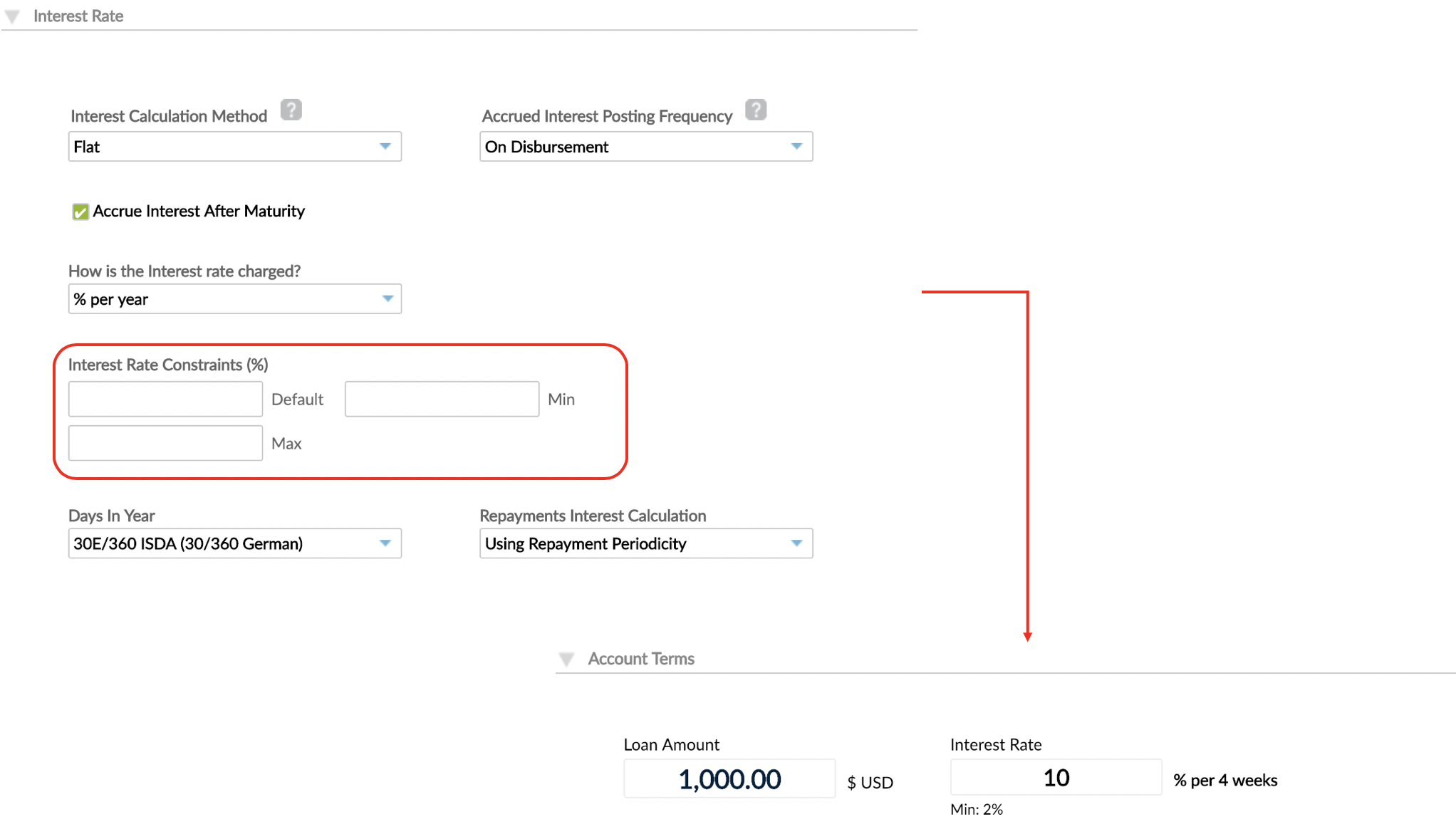
Calculating interest for Revolving Credit
For Revolving Credit loan products, you can select whether to calculate interest using the Principal Only, as is often the case in business loans, or based on Principal and Interest, as is common for credit cards.
Days in year
Depending on your internal practices, you may calculate interest over 365 or 360 days in a year. Given that interest accrues daily during a loan's lifetime, the interest due for any loan depends on the number of days in the month and is determined by the difference in the number of days between the last repayment and the current one.
In a 360-day year, every month is considered as having 30 days. The 365 days option takes the actual number of days in each month into account.
For more information on the different day count methodologies, see Interest Calculation Methods in Loans.
Repayments interest calculation for Fixed Term Loans
There can be occasions where the days between installments can differ from a regular schedule. For example, when there are either more or fewer days between disbursement and the first repayment than for the other installments, or when an installment's date is moved because of a holiday.
In this setting, you may specify whether you would like to consider the real number of days when calculating interest for the installment, or if all installments should have the same interest regardless of the number of days between each installment.
For example, consider a loan that is usually repaid once every two weeks. It is disbursed on December 1, but the first repayment date is set to December 20.
Although the repayment date is 19 days away from disbursement, if you do not want the interest calculation to consider the first repayment duration, you should use the option Using Repayment Periodicity. With that setting, it will be calculated as though it is just 14 days' worth of interest, like all other repayments. Every installment will be calculated with the same amount of interest, regardless of the actual number of days that have passed.
If you were to use Actual Number of Days instead, then the interest is calculated based on the actual number of days between December 1 and December 20 - that is, 19 days. This setting affects all installments with an unusual number of days because of holidays, or for any other reason.
For more information, see Interest Calculation Methods in Loans.
Repayment scheduling
Use this setting to choose how the repayment schedule will behave with prepayments, postpayments, or any extraordinary events.
With the Fixed method, the expected principal and interest are the same throughout the whole loan life cycle, regardless of extraordinary repayments. Its flexibility comes from the fact that it allows for editing the repayment schedules and manually moving due dates, reallocate principal, fees, and interest amounts between repayments.
With the Dynamic method, the repayments can be automatically recalculated when there is a prepayment or a postpayment. It is often useful for long-term loans.
Payment interval method
For Dynamic Term Loans, you can choose between:
- Interval: Use this setting to specify that payments should be made after certain periods of time—a month, a week, or some other value. You can then further customize the repayment frequency and constraints for offsetting the first due date.
- Fixed Days of Month: Choose this option if repayments should always fall on specific days of the month, such as always on the 1st and 15th of every month. This option is commonly used for payday loans, for instance.
Short month handling
If the Fixed Days of the Month option is set to have payments due on the 29th, 30th, or 31st day of the month, Short Month Handling will "move" the installment when the month has fewer days.
The system will create the installment for that month to be due to either last day of the month (such as the 28th) or the first day of the next month, depending on your choice.
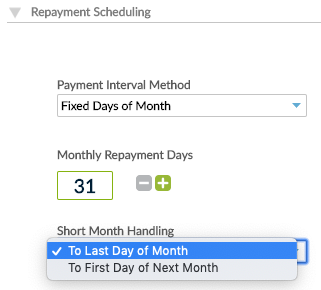
Defining the number of installments
To define the number of installments, enter the default, minimum, and maximum values in the appropriate fields.

Defining an amortization period
For dynamic term loans with a declining balance equal installment interest calculation method, you can define an amortization period with the standard payment method.

If the amortization period is defined when the loan product is created, the amortization period will be visible and editable when creating the loan account, and shown as a line item in the loan account overview.
In cases where the amortization period is longer than the number of installments, the system will compute the PMT as if the loan schedule was created for a longer period than the actual loan term. This results in the last installment being a balloon payment, due to a remaining principal balance.
For example
- Loan amount: 1,000,000
- Number of installments: 36 monthly installments
- Amortization period: 240 months
The PMT is computed based on the assumption that the loan is given for 240 months. Then, the loan schedule is created in the following way:
- The first 35 installments are computed using the standard Mambu calculation.
- Installment 36 is a balloon payment which includes the outstanding principal balance, as well as interest due as per the standard calculation.
The amortization period feature is available both via the UI and the API. Please reach out to your Customer Success Manager or contact Mambu Support to have it enabled.
First due date offset constraints
You can set the constraints for the number of offset days that can be established for the first repayment date.
The number of days you enter in Default will be automatically added to the first repayment due date when a new account is created under this product. The Minimum and Maximum values will determine the actual constraints for the offset days and ensure that users can only set a number of offset days that is within that limit.

Principal collection frequency
It is common in some countries to have repayment schedules in which clients pay principal on a certain number of installments and only interest on the others.
If you use this methodology, you can set the principal collection frequency by entering the number of installments for which there should be no principal collection.
Example of a loan account with Collection Repayment Frequency set at every three repayments.

Grace period
The grace period determines if the repayment schedules will include installments in which either principal only, or both interest and principal, are not paid. To define the Grace Period, click the dropdown list to choose the option you wish. There are three options:
- No Grace Period: Clients must pay principal and interest right away.
- Principal Grace Period: Clients pay only interest for the duration of the grace period.
- Pure Grace Period: Clients do not pay interest or principal for the duration of the grace period.

Repayment schedule with no grace period

Repayment schedule with Principal Grace Period

Repayment schedule with Pure Grace Period

Rounding of repayment schedules
Depending on the number of installments, some loan amounts end up with a small difference when divided by the number of installments. There are two options for dealing with this case:
- No Rounding: When there is a discrepancy between the loan amount to be disbursed and the total balance after rounding, Mambu shows a warning message asking you to either adjust the loan amount or the number of installments.
- Round Principal Remainder into Last Repayment: Mambu automatically adds the discrepancy amount to the last repayment.
For example, suppose you create a loan of USD1000 with three installments. This would result in a repayment schedule with installments of USD333.33 which would sum up to a total of only USD999.99 instead of USD1000. In this case, if you choose the rounding options, the missing cent is added to the last repayment (that is, to the second and third repayment schedules in this example).
Mambu cuts the calculations to 20 decimals, stores 20 decimals, and usually rounds to two decimals, depending on the currency used.
Rounding of repayment currency
In some countries, it is not common to use the currency's decimal values in daily life. In this case, when calculating repayment schedules, the repayments should be displayed as an amount that the client can actually pay. This typically means rounding installments to display a whole number.
If you want Mambu to automatically round your repayment schedules, choose one of the following options when creating a new product:
- No Rounding: Decimals are left as they are.
- Round to Nearest Whole Unit: 62.2 becomes 62 and 62.5 becomes 63.
- Round Up to Nearest Whole Unit: 62.2 becomes 63.
Repayment schedule with Rounding

Repayment Schedule with No Rounding
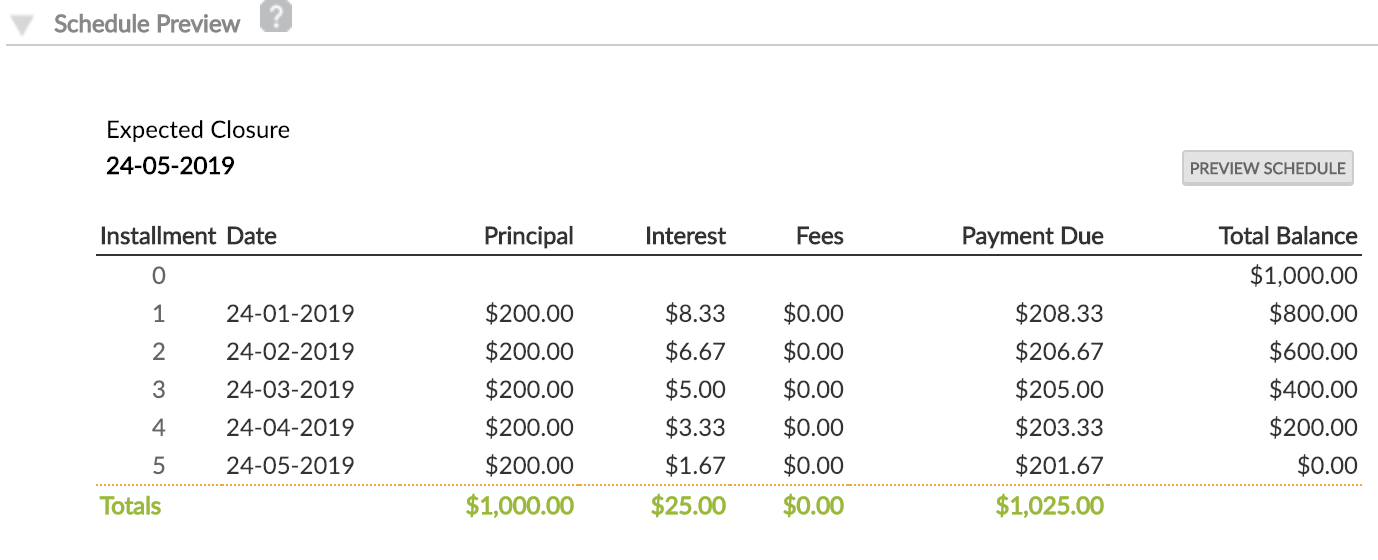
Repayments schedule editing
For more information about editing loan schedules, go to Repayments Schedule Editing.
Repayment collection
For settings for the Payment Allocation Method, pre-payment options, and Repayment Allocation Order, see Repayment collection.
Overdue payments settings
The setting Overdue Payments is usually set to Increase Overdue Installments. However, for a particular configuration (that is, if you select Reduce Number of Installments for Pre-Payment Recalculation), you can choose Increase Last Installment.
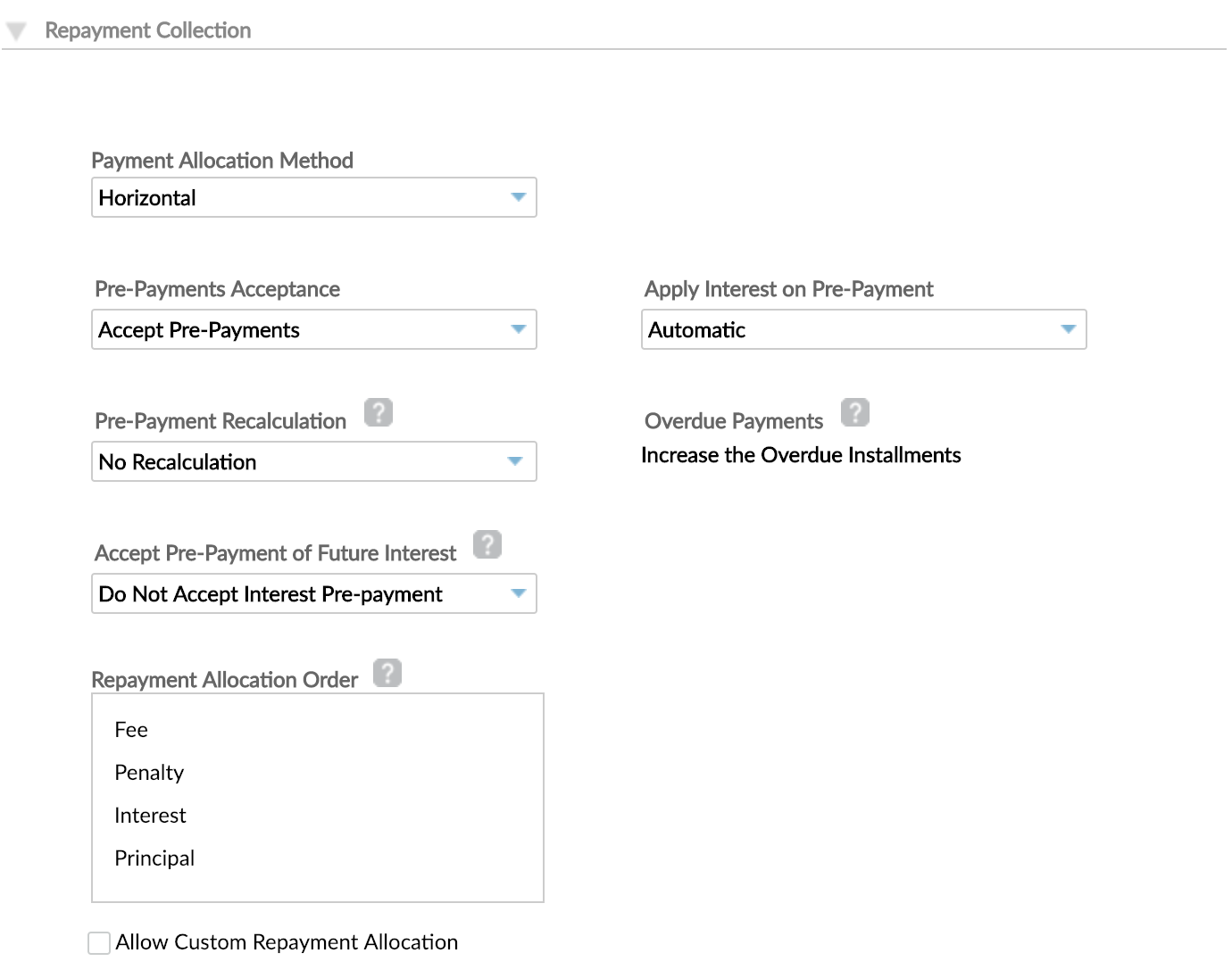
The purpose of the setting is to determine what to do with Interest from Arrears. When a loan is in arrears, additional regular interest is calculated on the overdue principal balance. This additional interest usually must be repaid in addition to the scheduled installment amount (that is, Increase Overdue Installments). If Increase Last Installment is selected, Mambu will not adjust the overdue installments, which results in an underpayment of principal. The principal will then be recouped in the last installment.
For illustration, see below for two identical loan accounts, one with Increase Overdue Installments, the other with Increase Last Installment. The loans were backdated so that there are late installments. The repayment made shows how the late or last installments were affected.
Increase Last Installment

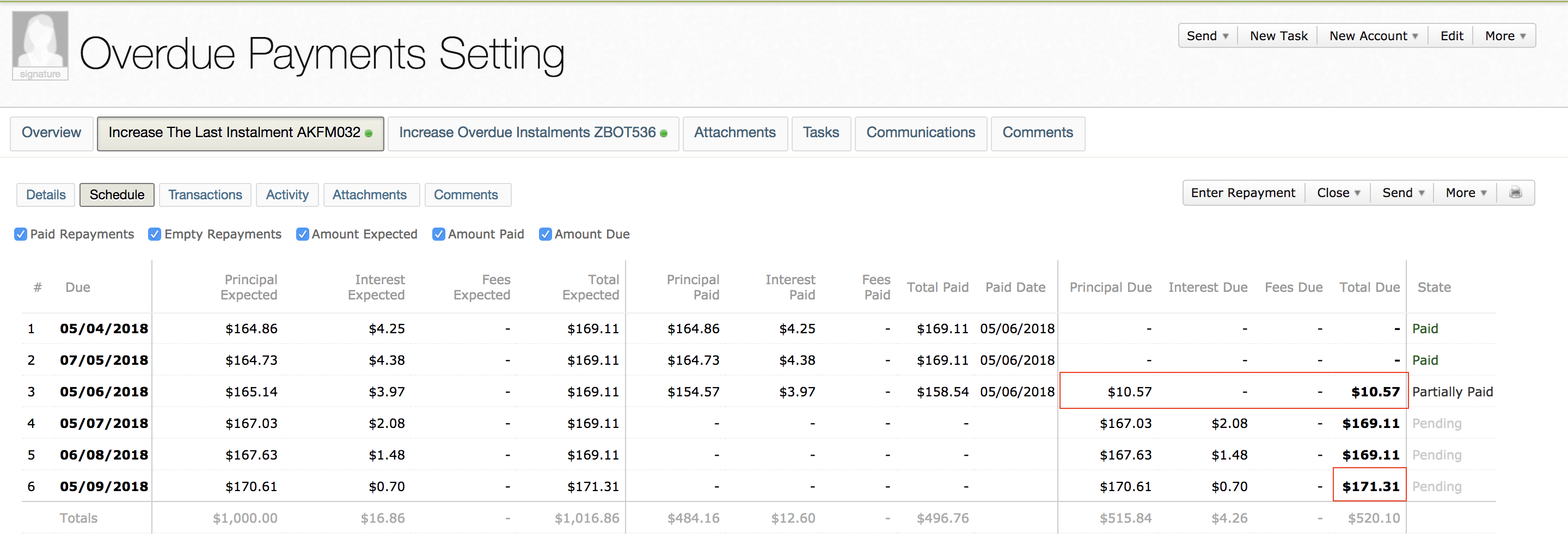
Increase Overdue Installment


Arrears settings
Arrears settings control how the number of days in which a loan is in arrears is calculated. These settings affect anything that is derived from a loan's days in arrears, such as penalties, notification templates, and reports.
For more information, see Arrears Settings
Penalties settings
Penalties are charges that are applied when loans go into arrears. For more information, see Loan Penalties Setup.
Internal controls
In this section, you can set up automatic controls for loans, such as the dormancy period, the number of days to wait before locking accounts in arrears, or automatically locking accounts in arrears when interest, fees, and penalties are more than a certain percentage of the current principal balance or of the original principal amount.
For more information, see Internal Controls.
Fees
Different types of fees may be applied to loan accounts. They are defined under each product. For more details on each type of fee and the available options, see Loan Fees Setup.
Product links
Select Enable Linking to allow loan repayments to be automatically made from a settlement deposit account. For more information, go to Linking deposit and loan accounts.
Funding sources
As of March 15, 2022, Mambu no longer offers the peer-to-peer (P2P) lending feature (also known as loan fractionalization).
Existing customers already using the P2P lending feature, will continue having access to it. However, any new enhancements or changes of this feature have ceased.
If you have any questions, please contact us through Mambu Support.
You can capture multiple funding accounts for a single loan account. We refer to this feature as loan fractionalization or peer-to-peer (P2P) lending. Mambu then keeps track of each individual funding account that contributes to a loan being disbursed and, as loan repayments are made by the borrower, returns the funds to investors together with a fraction of the interest paid by the borrower.
To enable funding sources:
- Select the Enable funding sources checkbox.
- Enter the minimum, maximum, and default commission values of the funding source.
- Choose the funder interest commission allocation from the list.
- Select Lock funds on funding account at approval to lock the funding account after it is approved.

For more information, see Funding Sources - P2P Lending.
Securities
Loan securities are used by organizations to secure some guarantee against the loan amount. For more information, go to Securities Settings.
Taxes
Many countries require organizations that offer loan accounts to pay taxes on the interest, fees, or penalty income generated on those accounts. These taxes are generally called "value-added taxes" or VAT, because they are collected on revenues.

The option under this section allows you to enable the value-added tax functionality by checking either of the "Apply taxes to" checkboxes for Interest, Fees and/or Penalties under the Taxes section.
For any of the checked options, Mambu will calculate taxes each time they are applied on the loan accounts, depending on the type of tax, as described below.
Tax Rate Source
To be able to add taxes on a loan product, a tax rate source must be previously defined under the Administration > Financial Setup > Rates section. For more information, see Customizing Index Interest Rates & Tax Rates.
Tax Calculation Method
Value-added taxes on loan accounts may be either exclusive or inclusive.
Inclusive VAT
Inclusive taxes are already included and calculated for any interest, fee, or penalty income.
If the total interest, fee, or penalty income computed is USD100 and the Value Added Taxes (VAT) is 10% of that, the formula used is x + 10% of x = $100. x is the interest amount, while 10% of x is the VAT amount.
To find just the interest income you would solve for x with the formula x = USD100 / (1+10%) and get an interest income of USD90.91. The VAT amount added to that is USD9.09 to get a total of USD100.
Exclusive VAT
Exclusive taxes are calculated on top of the stated interest, fee, or penalty amount. For example, a 10% exclusive tax rate on an interest income of USD100 will result in USD10 as VAT, which will be added on top of the USD100 interest, meaning a total charge of USD110 (USD100 interest + USD10 taxes).
Accounting rules
These settings control whether or not the product will be linked to the accounting module and which methodology to use.
After choosing the methodology—Cash or Accruals based accounting—you may define the accounting rules for that product. To do so, select the appropriate GL account for each action.
For more details on each methodology and on the accounting rules, see Cash vs. Accruals Accounting.


